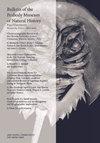北美常见斑蝥的分子变异及生物地理学研究
IF 0.9
4区 哲学
Q2 BIODIVERSITY CONSERVATION
引用次数: 2
摘要
寄生斑龟(Placobdella parasitica, Say, 1824)是北美洲最常见的龟水蛭之一。利用细胞色素c氧化酶亚基I基因对寄生在北美的不同种群进行分子分析,发现存在9个不同的类群:(1)狭义寄生蜂(P. parasitica stricu stricto),包括新种在内,广泛分布于美国中部,从密西西比河向西至落基山脉,横跨加拿大安大略省南部和美国中西部上游,东至纽约州;(2)西弗吉尼亚州;(3)密西西比/阿拉巴马州;(4)东北地区,包括纽约州、马萨诸塞州和佛蒙特州;(5)新英格兰,包括罗德岛州、马萨诸塞州和康涅狄格州;(6)北卡罗莱纳州/西弗吉尼亚州;(7)南卡罗来纳州;田纳西州(8);(9)佛罗里达州。邻居连接和最大似然分析都发现沿阿巴拉契亚山脉有东西分裂,1-3组聚在一起,4-9组分开聚在一起,除了8组(田纳西州)与东部组在一起。第1组包括来自广泛地理分布的标本,但遗传变异相对较低,在北美的其他舌音类物种中也观察到这种模式。在阿巴拉契亚山脉以东有成员的群体按地域分布更紧密。众所周知,这种水蛭会寄生于几种龟类,包括起源于墨西哥湾中部沿岸地区的彩龟,它向北扩散,代表了更新世冰川期后的重新殖民。邻居连接树和成对距离数据表明,寄生蜂与其宿主龟具有相似的系统地理模式和传播历史。鉴于各类群间形态的一致性,暂认为寄生蜂是一种分布广泛、分子变异较大的种。本文章由计算机程序翻译,如有差异,请以英文原文为准。
Molecular Variation and Biogeography of the Common North American Turtle Leech, Placobdella parasitica
Abstract Placobdella parasitica (Say, 1824) is one of the most commonly encountered turtle leeches in North America. Molecular analysis of individuals of P. parasitica representing various populations throughout its range in North America using the cytochrome c oxidase subunit I gene, revealed the presence of nine distinct groups: (1) P. parasitica sensu stricto containing members, including the neotype specimen, occurring broadly throughout the central United States westward from the Mississippi River to the Rocky Mountains and throughout southern Ontario, Canada, and the upper midwestern United States as far east as New York State; (2) West Virginia; (3) Mississippi/Alabama; (4) Northeast, including New York, Massachusetts, and Vermont; (5) New England, including Rhode Island, Massachusetts, and Connecticut; (6) North Carolina/West Virginia; (7) South Carolina; (8) Tennessee; and (9) Florida. Both neighbor-joining and maximum likelihood analyses recovered an east-west split along the Appalachian Mountains with groups 1–3 clustering together and groups 4–9 clustering separately, with the exception of group 8 (Tennessee) that placed with the eastern groups. Group 1 includes specimens from a broad geographic distribution, yet with relatively low genetic variation, a pattern observed in other glossiphoniid species in North America. The groups with members east of the Appalachian Mountains are more tightly clustered by locality. This leech species is known to parasitize several turtle species, including Chrysemys picta, the painted turtle that originated in the central Gulf Coast region and dispersed northward representing a recolonization after Pleistocene glaciation. The neighbor-joining tree and pairwise distance data could suggest that P. parasitica has a similar phylogeographic pattern and dispersal history with its turtle hosts. In view of the morphological uniformity among the various groups, P. parasitica is provisionally considered to be a widely distributed, molecularly variable species.
求助全文
通过发布文献求助,成功后即可免费获取论文全文。
去求助
来源期刊

Bulletin of the Peabody Museum of Natural History
BIODIVERSITY CONSERVATION-ECOLOGY
CiteScore
2.40
自引率
0.00%
发文量
6
审稿时长
>12 weeks
期刊介绍:
The Bulletin of the Peabody Museum of Natural History publishes original research based on specimens, artifacts and related materials maintained in the collections of the Yale Peabody Museum of Natural History’s curatorial divisions. The Bulletin is published twice a year, in April and October.
 求助内容:
求助内容: 应助结果提醒方式:
应助结果提醒方式:


